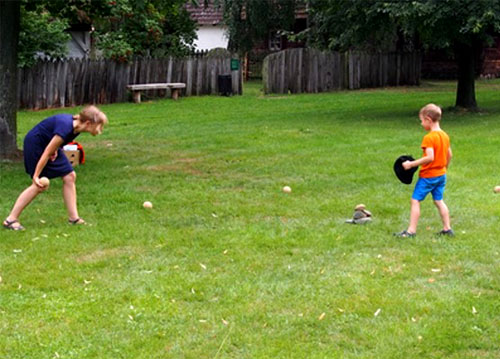Info
Kapela consists in playing a kind of a duel between two players. One person, acting as a so-called Kapelamaster, stands in the middle of the field with a hat /a cup on his/her head (you can use also e.g. bean bags instead of hats) and puts a small construction of stones (one on another) next to him or her. It resembles a chapel – hence the name of the game.
Around the Kapelamaster, there are usually 8 players who form a circle. Each of them has a wooden ball in his hand (it was a stone in the past).
One of these players starts the game by throwing or rolling the ball towards the stone chapel so that it falls over. If he or she succeeds, he/she runs for the ball and returns with it (the same path) to his/her place.
At the same time, the task of Kapelamaster is to rebuild the chapel and then to throw a cap / a hat (from his/her head) at the player running after the ball. If he hits him/her, before he/she returns with the ball to his/her place, the hit person becomes the new Kapelamaster. If Kapelamaster misses or fails to rebuild the chapel (or the stones fall during the game), Kapelamaster remains in his/her place and another player from the circle tries to knock down the stone chapel, by throwing or rolling his/her ball.
There are basically no winners or losers in this game.
History
The name of this game comes from an Italian word capella (Eng: the Chapel).
In the past, shepherds used to play it at Kociewie (Pomerania region at the seaside in northern Poland). They had many field stones in this area, which they were using to play.
Over time, this game was forgotten but in the recent decades it has been reactivated in some villages of Kociewie region by local authorities.
Physical abilities developed
motor skills: coordination and body balance, accuracy of throws, reaction speed, agility; social: building bonds between players;



